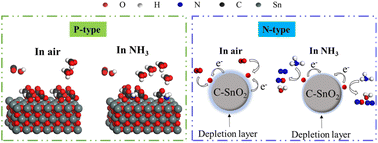Highly selective room temperature ammonia gas sensors based on d-band C-SnO2 and response behavior induced by oxidative and reductive role shifts†
Abstract
The sensing mechanism of oxygen adsorption and desorption using the Wolkenstein model has been the main mechanism of semiconductor sensing since it was proposed in the 1990s. However, it is difficult for metal oxide-based sensors aimed at ammonia (NH3) to achieve the lower limit of sub-ppm detection, high selectivity, high response, and room temperature operation simultaneously under the oxygen adsorption desorption mechanism of interaction. In view of this, inspired by the recent discovery of the interaction between CO2-catalyzed intermediates and organic amines in catalysis, the CO2-catalyzed intermediate adsorption-based sensing mechanism for ammonia gas was proposed, utilizing CO2 to achieve adsorption–desorption equilibrium instead of oxygen in the sensing process. In the response process, C-SnO2 provides a reductive role rather than the traditional oxidative role and has the advantages of high selectivity, anti-interference and low lower detection limits for ammonia gas at room temperature. Meanwhile, density functional theory (DFT), X-ray photoelectron spectroscopy (XPS) and Fourier transform infrared (FTIR) spectroscopy provide an in-depth explanation of oxidative and reductive roles of C-SnO2. The oxidative and reductive role shifts of the material lead to P-type response behavior and N-type response behavior. The N-type response essentially presents a dynamic balance of O2 oxidation and NH3 reduction, while the P-type response essentially presents a dynamic balance of CO2 catalyzed reduction and NH3 oxidation. Meanwhile, C doping improves the d-band of Sn and increases the adsorption energy of the material to –COOH and –OCOO–, which provides a significant improvement to the P-type response process.



 Please wait while we load your content...
Please wait while we load your content...